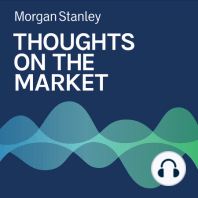4 min listen

Serena Tang: Global Cross-Asset Risk Premiums
Serena Tang: Global Cross-Asset Risk Premiums
ratings:
Length:
4 minutes
Released:
Aug 31, 2022
Format:
Podcast episode
Description
While markets wrestle with high inflation and recession worries, investors will want to keep an eye on the rise in risk premiums and the outlook for long-run returns.-----Transcript-----Welcome to Thoughts on the Market. I'm Serena Tang, Morgan Stanley's Head of Cross-Asset Strategy for North America. Along with my colleagues, bringing you a variety of perspectives, today I'll focus on the current state of global cross-asset risk premiums. It's Wednesday, August 31st at 10 a.m. in New York. Markets in 2022 have been incredibly turbulent, and global cross-asset risk premiums have shifted dramatically year to date. Various markets have been buffeted by higher inflation and tighter policy, geopolitical risks and worries about recession. Some impacted much more than others. What this means is that there are segments of markets where risk premiums, that is the excess returns an investor can expect for taking on additional risk, and long-run expected returns look much more attractive than they were at the beginning of the year. And while expected returns and risk premiums have broadly risen, the improvements have been uneven across asset classes and regions. For example, we believe that compared to U.S. stocks, rest-of-world equities have seen equity risk premiums move much higher since December, and currently have an edge over U.S. equities in terms of risk reward, in line with our relative preferences. So let me put some actual numbers around some key regional disparities. Our framework, which incorporates expectations on income, inflation, real earnings growth and valuations, see U.S. equities returning about 7.5% annually over the next decade, compared to just 5.7% at the start of the year. However, a steep climb in U.S. Treasury yields from historical lows mean that from a risk premium perspective, U.S. equities is still below its 20 year historical average by nearly one percentage point. This is in contrast to other regions whose risk premiums have increased significantly more during the sell off. Notably, European equity risk premiums are 8.9%, close to a 20 year high, similarly for emerging markets at 5.3%, and Japanese equity risk premiums at 4.7%, also above average. And remember, higher risk premiums typically signal that it's a good time to invest in riskier assets. For fixed income, with nominal yields rising on the back of more persistent inflationary pressures and quantitative tightening, long-run expected returns are now higher than they were 12 months ago. In fact, we're now back to levels last seen in 2019. Our framework now predicts that ten year U.S. Treasuries can return 3.7% annually over the next decade, up from 2.2% just a year ago. Credit risk premiums, such as for corporate bonds, have also readjusted year to date. As with risk free government bonds, rising yields mean that long run expected returns for these bonds have improved significantly since the start of the year. In terms of numbers, our model forecasts for U.S. high yield risk premium, at 188 basis points compared to near nothing 12 months ago. So what does all this mean? Well, for one thing, as my colleague Andrew Sheets has pointed out in a previous Thoughts on the Market episode, lower prices, wider risk premiums and higher 10 year expected returns have raised our long-run expected returns forecasts for a portfolio of 60% equity and 40% high quality bonds to the highest it's been since 2019, above the 10 year average. So we believe that the case for a 60/40 type of approach remains. For another, it means that the opportunities for investors right now lie in relative value rather than beta, given our strategists macro outlook for the next 12 months is more cautious than our long-run expected forecast. So for example, based on our long-run expected returns, our dollar optimal portfolios favor segments of the markets with more credit risk premium, like high yield and emerging market bonds. And similarly, as I've mentioned before, our current cross-
Released:
Aug 31, 2022
Format:
Podcast episode
Titles in the series (100)
Andrew Sheets: Fed to the Rescue? Maybe Not. by Thoughts on the Market